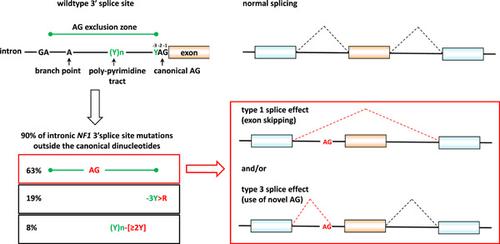当前位置:
X-MOL 学术
›
Hum. Mutat.
›
论文详情
Our official English website, www.x-mol.net, welcomes your
feedback! (Note: you will need to create a separate account there.)
AG-exclusion zone revisited: Lessons to learn from 91 intronic NF1 3' splice site mutations outside the canonical AG-dinucleotides.
Human Mutation ( IF 3.3 ) Pub Date : 2020-03-11 , DOI: 10.1002/humu.24005 Katharina Wimmer 1 , Esther Schamschula 1 , Annekatrin Wernstedt 1 , Pia Traunfellner 1 , Albert Amberger 1 , Johannes Zschocke 1 , Peter Kroisel 2 , Yunjia Chen 3 , Tom Callens 3 , Ludwine Messiaen 3
Human Mutation ( IF 3.3 ) Pub Date : 2020-03-11 , DOI: 10.1002/humu.24005 Katharina Wimmer 1 , Esther Schamschula 1 , Annekatrin Wernstedt 1 , Pia Traunfellner 1 , Albert Amberger 1 , Johannes Zschocke 1 , Peter Kroisel 2 , Yunjia Chen 3 , Tom Callens 3 , Ludwine Messiaen 3
Affiliation

|
Uncovering frequent motives of action by which variants impair 3' splice site (3'ss) recognition and selection is essential to improve our understanding of this complex process. Through several mini-gene experiments, we demonstrate that the pyrimidine (Y) to purine (R) transversion NM_000267.3(NF1):c.1722-11T>G, although expected to weaken the polypyrimidine tract, causes exon skipping primarily by introducing a novel AG in the AG-exclusion zone (AGEZ) between the authentic 3'ss AG and the branch point. Evaluation of 90 additional noncanonical intronic NF1 3'ss mutations confirmed that 63% of all mutations and 89% (49/55) of the single-nucleotide variants upstream of positions -3 interrupt the AGEZ. Of these AGEZ-interrupting mutations, 24/49 lead to exon skipping suggesting that absence of AG in this region is necessary for accurate 3'ss selection already in the initial steps of splicing. The analysis of 91 noncanonical NF1 3'ss mutations also shows that 90% either introduce a novel AG in the AGEZ, cause a Y>R transversion at position -3 or remove ≥2 Ys in the AGEZ. We confirm in a validation cohort that these three motives distinguish spliceogenic from splice-neutral variants with 85% accuracy and, therefore, are generally applicable to select among variants of unknown significance those likely to affect splicing.
中文翻译:

重新审视 AG 排斥区:从规范 AG-二核苷酸之外的 91 个内含子 NF1 3' 剪接位点突变中学习的经验教训。
揭示变体损害 3' 剪接位点 (3's) 识别和选择的频繁行动动机对于提高我们对这一复杂过程的理解至关重要。通过几个小基因实验,我们证明了嘧啶 (Y) 到嘌呤 (R) 的颠换 NM_000267.3(NF1):c.1722-11T>G,虽然预计会削弱多嘧啶束,但主要通过引入导致外显子跳跃在真实 3 的 ss AG 和分支点之间的 AG 排除区 (AGEZ) 中的新 AG。对 90 个额外的非规范内含子 NF1 3 ss 突变的评估证实,所有突变的 63% 和位置 -3 上游的单核苷酸变体的 89% (49/55) 中断了 AGEZ。在这些 AGEZ 中断突变中,24/49 导致外显子跳跃,表明该区域中没有 AG 对于在剪接的初始步骤中已经准确选择 3 ss 是必要的。对 91 个非经典 NF1 3 ss 突变的分析还表明,90% 要么在 AGEZ 中引入新的 AG,在位置 -3 引起 Y>R 颠换,要么在 AGEZ 中移除≥2 个 Y。我们在一个验证队列中确认,这三个动机以 85% 的准确度区分剪接变异和剪接中性变异,因此,通常适用于在可能影响剪接的未知意义的变异中进行选择。
更新日期:2020-03-11
中文翻译:

重新审视 AG 排斥区:从规范 AG-二核苷酸之外的 91 个内含子 NF1 3' 剪接位点突变中学习的经验教训。
揭示变体损害 3' 剪接位点 (3's) 识别和选择的频繁行动动机对于提高我们对这一复杂过程的理解至关重要。通过几个小基因实验,我们证明了嘧啶 (Y) 到嘌呤 (R) 的颠换 NM_000267.3(NF1):c.1722-11T>G,虽然预计会削弱多嘧啶束,但主要通过引入导致外显子跳跃在真实 3 的 ss AG 和分支点之间的 AG 排除区 (AGEZ) 中的新 AG。对 90 个额外的非规范内含子 NF1 3 ss 突变的评估证实,所有突变的 63% 和位置 -3 上游的单核苷酸变体的 89% (49/55) 中断了 AGEZ。在这些 AGEZ 中断突变中,24/49 导致外显子跳跃,表明该区域中没有 AG 对于在剪接的初始步骤中已经准确选择 3 ss 是必要的。对 91 个非经典 NF1 3 ss 突变的分析还表明,90% 要么在 AGEZ 中引入新的 AG,在位置 -3 引起 Y>R 颠换,要么在 AGEZ 中移除≥2 个 Y。我们在一个验证队列中确认,这三个动机以 85% 的准确度区分剪接变异和剪接中性变异,因此,通常适用于在可能影响剪接的未知意义的变异中进行选择。











































 京公网安备 11010802027423号
京公网安备 11010802027423号